The living history of cities. 12 select sites for tourists: Fukuoka, Hakata, and Tenjin.
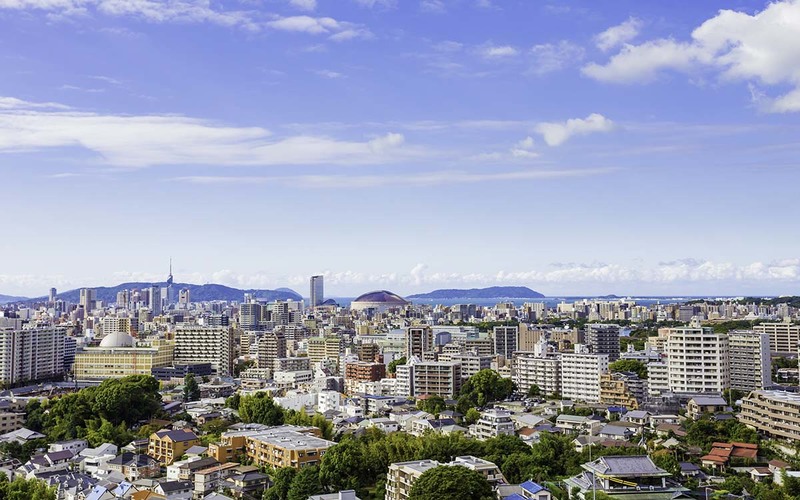
Fukuoka/Hakata/Tenjin Area
Famous foods in Hakata Fukuoka, such as Hakata Ramen, Mentaiko, Mizutaki, and Motsunabe are featured on TV, in magazines and on the internet.
Also, many historical temples for sightseers, such as Dazaifu Tenman-gu Shrine, Kushida Shrine, Tochoji Temple, and Sumiyoshi Shrine are in the area.
Connecting the mainland Kyushu and Shikanoshima, these resort sites in Fukuoka offer great alternative entertainment: the famous dolphin and sea lion performances at the 'Marine World Umino Nakamichi' aquarium, and a visit to the 'Uminonakamichi Seaside Park' beach.
These sites are all very easily accessible.
The Fukuoka Airport is the only aiport in Japan with direct access to the subway.
It takes about 5 minutes by subway from the airport to Hakata station and about 11 minutes from the airport to Tenjin. For this reason, if you visit these sites, the subway is indispensible.
Also, it is recommended that you use "100 yen Circular Route Bus" operated by Nishitetsu Bus, from Hakata to Tenjin.
40-006-01_%E3%81%A4%E3%81%B0%E3%82%81%E3%81%AE%E6%9D%9C%E3%81%B2%E3%82%8D%E3%81%B0.jpg)
A Tsubame No Mori Hiroba
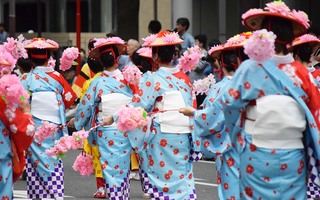
B Hakata Dontaku
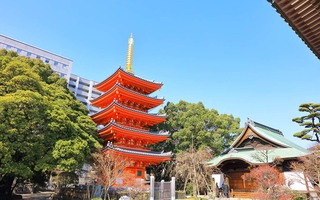
C Tochoji Temple The Great Buddha of Fukuoka
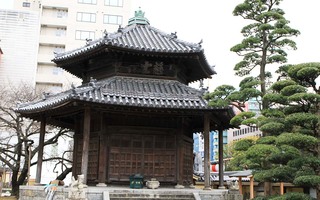
D Tochoji Temple Rokkakudo
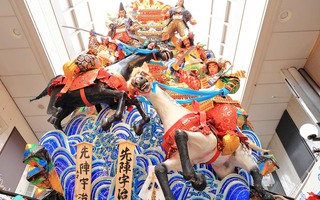
E Hakata Gion Yamakasa
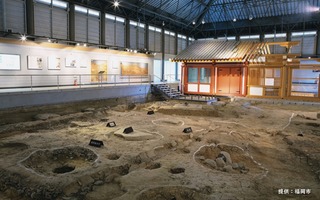
F Korokan Historical Museum
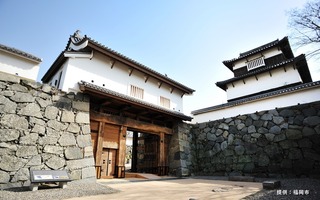
G Fukuoka Castle Ruins
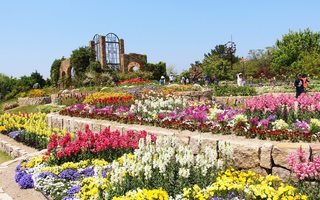
H Uminonakamichi Seaside Park
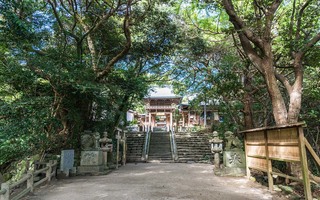
I Shikanoshima Island
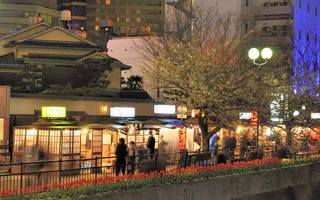
J Yatai (food cart)
A
Tsubame No Mori Hiroba
40-006-01_%E3%81%A4%E3%81%B0%E3%82%81%E3%81%AE%E6%9D%9C%E3%81%B2%E3%82%8D%E3%81%B0.jpg)
Tsubame No Mori Hiroba is on the rooftop of JR Hakata City connected to JR Hakata Station.
The site is off the beaten track, and contains Tetsudo Shrine, where many people pray for safe travels.
Enter the 'Monzen-machi', through the four gateway frames, and you can see a 'Haiden' or hall of worship.
The famous steam train, "Tsubame Densha", goes around the 'Tenku No Hiroba' twice when you get on.
The steam train is designed by Eiji Mitoka, who designed many trains, such as the Shinano Railway "Rokumon" and the "Nanatsu Boshi" a Kyushu Luxury Sleeper Train.
If the weather is nice, you may also enjoy seasonal flowers at 'Tenku No Hiroba' and the stunning panoramic view of Fukuoka city from the viewing terrace.
B
Hakata Dontaku

Hakata Dontaku, known as one of the three biggest Japanese Festivals, takes place on the 3rd and 4th of May every year.
There are over 30,000 participants and over 2 million spectators, so the festival is very crowded every year.
The history of Hakata Dontaku dates back the late 12th century and it is said that it started when the New Year was celebrated as 'Matsuri-Bayashi'.
Since then, the festival has been developed into the event celebrated by Hakata merchants.
In 1873, Matsuri-Bayashi was not allowed by the new Meiji Government, however, in 1880, it was renamed and reborn as Hakata Dontaku.
Dontaku supposedly derives from the Dutch holiday 'Zondag'.
Currently, the participants use their hand to hit and ring a 'Shamoji' rice scoop, while walking and dancing.
This supposedly originated from the land-ladies of merchant houses being fascinated by the sound of Matsuri Bayashi, and hitting Shamoji when they made dinner.
C
Tochoji Temple The Great Buddha of Fukuoka

Tochoji is the first temple built in Japan by the famous Buddhist monk, Kukai Kobo Daish.
Kukai returned to Japan from the ancient Chinese Province of Tang, and built the temple in 806 to spread awareness of Shingon Esoteric Buddhism to the East.
The idol of 'The Senju Kannon Bodhisattva', or Thousand-Armed Kannon, in Tochoji was created in the Heian period. Whereas its height is relatively small at 87cm, it was designated as a national treasure in the Meiji period.
The giant Buddha statue, Fukuoka Daibutsu, whose height is 10.8 meters and weight is 30 tons, is enshrined at Daibutsu-den, the second floor of the main temple.
The creation of this Daibutsu was finished in 1992.
It is the largest among enshrined Daibutsus made of wood in Japan.
Picture scrolls with depictions of Hell are displayed on the Daibutsu's base.
It is also said that if you touch the Wheel of Buddha, 'Hotoke No Wa' in the dark corridor, you can go to Heaven.
Therefore, it is commonly known as "Jigoku Gokuraku Meguri", or the 'Heaven and Hell Tour'.
D
Tochoji Temple Rokkakudo

Rokkakudo stands on the corner of Tochoji Temple and was built in 1842.
Rokkaku means hexagon, so not only the Buddha hall, but also the Butsugan inside are hexagonal shapes.
The Butsugan is a small space where a Buddha statue is enshrined.
The Butsugan enshrined in Rokkakudo include the Monju Bodhisattva, Jizo Bodhisattva, Healing Buddha Statue, White Robe Kannon Statue, and North Star Talisman Idol.
In addition, because the Butsugan in Rokkakudo revolves, it is called a Rinzo.
This was supposedly created for people who were illiterate and could not read the sutras.
After it revolved, followers could practice the virtues while others read the sutras.
The Buddhist Scripture Rinzo painting of Zushi Tobira was created using caligraphy brushes and is open to the public on the 28th of every month.
E
Hakata Gion Yamakasa

The Hakata Gion Yamakasa Summer Festival is held from July 1st to July 15th. The festival creates a lively summer in Hakata. The Hakata Gion Yamakasa has two types, Kaki Yamakasa and Kazari Yamakasa.
A Kaki Yamakasa is a giant moveable shrine, also called a Mikoshi, and carried on the shoulders of men through the city from July 10th until the finale.
There are seven areas called Nagares, which divide the river and streets.
In each Nagare, men carry different Yamakasas.
Also, from July 15th, a time trial race called the Oiyama begins.
The race is approximately 5 kilometers, starting from Kushida Shrine and finishing at the Old Site of the Magistrate's Office.
One part of the course is called 'Kushida Iri' as it runs through Kushida Shrine .
Runners compete for the best times for the 'Kushida Iri' section and for the entire course which goes through all of the Nagares.
A rehearsal run called the Oiyama Narashi is held on July 12th, where competitors run 4 kilometers to a different goal at the intersection of Naraya-machi.
The other Yamakasa, Kazari Yamakasa, are decorational Mikoshi which display impressive and rich shrines at 14 sites in and outside of the Nagares.
The decorations of Hakata Yamakasa, include realistic Samurai Dolls, called Busho Ningyo and beautiful Angel decorations, called Tennyo, created by Hakata Puppeteers.
F
Korokan Historical Museum

Korokan is an ancient guest house built in the 7th century for diplomacy and foreign trade.
It is said that it welcomed envoys, delegates from the ancient Korean Kingdom of Shiragi, and merchants for 400 years.
The oldest Chronicles of Japan describe how Shiragi delegates were welcomed in the year 688.
It's name during the Nara period was Tsukushi No Murotsumi, but was changed to Korokan in the early Heian period.
The name Ko-ro-kan derives from the Ministry of Foreign Affairs in the ancient Chinese Province of Tang which is named, 'Ko-ro-ji'. Ko meaning "Large" and Ro meaning "Communication".
There were several Korokans built in Heian-kyo in Kyoto, Namba in Osaka, and in here in Fukuoka.
However, the remains of a Korokan were only found in Fukuoka.
After the remains were found in 1987, excavation and research started the next year.
To protect the excavated remains from stormy weather, special covering roofs were built so that cornerstones and other remnants could be displayed in the same condition as when they were found.
G
Fukuoka Castle Ruins

Fukuoka Castle was built in the early 17th century by Nagamasa Kuroda and his father, Josui Kuroda, the chief strategist for the famous samurai, Hideyoshi Toyotomi.
Josui was born in Harima, located in the present Kobe Prefecture.
After being rewarded for his deeds in the Kyushu Conquest, he moved to Buzen, which is now in Oita Prefecture.
His son, Nagamasa, achieved great military exploits in the Battle of Sekigahara so the Shogun founder, Ieyasu Tokugawa, rewarded him the land of Chikuzen Province so that he and his father could live in the same area.
The name Fukuoka was taken from a name connected to the Kuroda famiy in the Okayama Prefecture, 'Bizen No Kuni Okugun Fukuoka' .
Nagamasa used this to name the castle, Fukuoka Castle.
Even though Hakata had flourished on its own as a merchant city for a long time, Fukuoka and its surrounding castle town were born at the same time.
As the two cities were born at the same time, they are now characterized as twin cities.
Fukuoka Castle was demolished by the Ordinance abolishing castles in the early Meiji period, and only stone walls remain.
However, you still can see a model of the original castle inside this site.
H
Uminonakamichi Seaside Park

Uminonakamichi Seaside Park is a large national park surrounded by Hakata Bay and Genkai Sea.
The site is approximately 300 hectares, which is the same area as 64 Tokyo Domes.
In the park, you can enjoy a Flower Picnic, famous Japanese gourmet from C-1 CUP in UMINAKA, a BBQ Lecture, a canoe experience, and much more while viewing seasonal flowers throughout the year.
In 2018, a new baby sheep was added to the Animal Forest for the first time in 6 years and has become very popular.
The Animal Forest is already very popular with children, where they can enjoy petting and feeding animals including: squirrels monkeys, capibaras, and kangaroos.
In addition, you can enjoy cycling and a pool with the exciting Dragon Water Slide.
Also, you can silently experience the stunning view of "Umi No Matsubara" from the observation platform.
People all ages will be satisfied with the Uminonakamichi Seaside Park.
I
Shikanoshima Island

Shikanoshima Island is famous for the national treasure Kin-in, or, 'King of Na gold seal'.
Kin-in was found by a farmer who worked in a paddy field in the mid Edo period.
After that, it was owned by the Kuroda family, who reigned as feudal lords, over the ancient Province of Chikuzen.
Currently, Kin-in is housed in the Fukuoka City Museum.
Shikanoshima Island's appeal is its beautiful sea which is clear all the way down to the bottom.
As well as admiring a view of the sea, you can enjoy diving and snorkeling to view rare tropical fish.
The protectorate god of the sea is enshrined at Shikaumi Shrine and is a well-known Power Spot.
There are 70 festivals held here every year. Among them, it is highly recommended that you enjoy the Taisai festival in Fukuoka Prefecture.
J
Yatai (food cart)

Japanese food carts, called Yatai, are one of Hakata's summer night features.
Tenjin or Nakasu Yatai in Hakata are often featured on TV, in magazines, and on the internet.
Not only is Nagahama Ramen very famous, but a wide range of food: such as Oden, Motsunabe, Kushiage, and Tempura can be found at Yatai.
If you wish to taste all the food you want, you should try eating everything little by little.
Be careful, as Yatai price lists are not often displayed and not all Yatai are equal when it comes to cleanliness.
It's also recommended that you find a toilet before eating there.
To find the best Yatai, ask local taxi drivers or hotel receptionists for their recommendations.